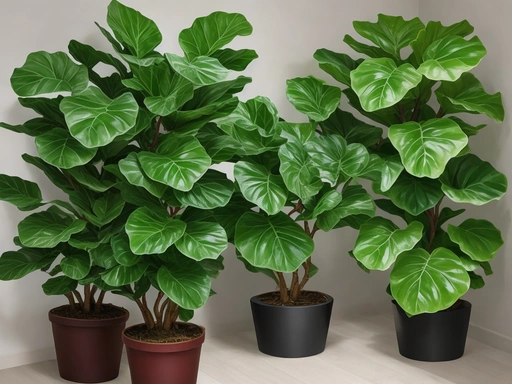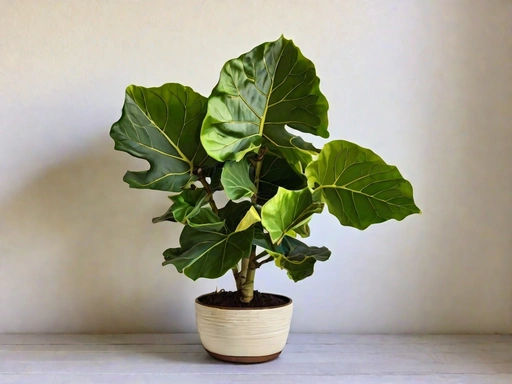Fiddle-Leaf Fig And Natural Light Requirements: The Ultimate Guide for 2023
Embarking on a journey of indoor plant mastery? Your first stop: understanding the intimate relationship between the fiddle-leaf fig and natural light. This guide illuminates the secrets to nurturing these stunning plants, revealing how the right amount of sunlight can transform your fiddle-leaf fig into a vibrant centerpiece of any room. Let’s delve into the world where light meets leaf, and growth becomes art.
Key Takeaways Fiddle-Leaf Fig Plants and Natural Light:
- Fiddle-leaf figs thrive in bright, indirect sunlight.
- They should be placed near a window with filtered or diffused light.
- Avoid exposing them to harsh, direct sunlight to prevent leaf burn.
- Regularly rotate the plant to ensure even and balanced growth.
Are you a proud plant parent who’s been charmed by the beauty of fiddle-leaf fig plants?
Well, you’re not alone! These striking houseplants have become incredibly popular in recent years.
But here’s the thing: fiddle-leaf figs have a unique love affair with natural light.
Getting the right amount of sunlight is crucial for their growth and overall well-being.
In this article, we’ll dive into the importance of natural light for fiddle-leaf fig plants, how to assess the natural light in your home and provide some handy tips to ensure your leafy friend thrives in the light it craves.
So, let’s shed some light on this fascinating topic!
| Fiddle-leaf Fig | Natural Light Requirements |
|---|---|
| Sunlight | Indirect, bright light |
| Duration | 4-6 hours of bright light daily |
| Direct Sunlight | Avoid exposure to direct sunlight |
| Too Much Light | Avoid prolonged exposure to intense, direct light |
| Shade | Avoid placing in deep shade |
| West or East-Facing Window | Provides ideal light conditions |
| Southern Exposure | May require additional shading |
| Northern Exposure | May not receive enough sunlight, may need supplemental lighting |
The Importance of Natural Light for Fiddle-Leaf Fig Plants

Fiddle-leaf fig plants rely on natural light for their growth and overall health.
Understanding Fiddle-Leaf Fig Plants
Fiddle-leaf fig plants, also known as Ficus lyrata, are popular houseplants admired for their large, glossy leaves.
They are native to the tropical rainforests of West Africa.
Fiddle-leaf figs can grow up to 10 feet tall indoors and require bright, indirect light to thrive.
Understanding their natural habitat and light requirements is key to successfully caring for these beautiful plants.

Benefits of Natural Light for Fiddle-Leaf Fig Plants
Natural light is essential for fiddle-leaf fig plants.
It helps them thrive and stay healthy.
Here are some benefits:
- Promotes growth: Natural light stimulates photosynthesis, aiding leaf and stem development.
- Enhances color: Sunlight intensifies the leaves’ vibrant green color, making them look more beautiful.
- Improves overall health: Exposure to natural light boosts immune function and reduces the risk of diseases in fiddle-leaf fig plants.
- Prevents leggy growth: Ample natural light prevents the elongation of stems and helps maintain a compact, bushy shape.
- Increases resilience: Plants exposed to natural light are more resilient to stressors and better equipped to handle changes in their environment.
So, ensure your fiddle-leaf fig gets enough natural light to enjoy these benefits!

How Much Natural Light Do Fiddle-Leaf Fig Plants Need?
Fiddle-leaf fig plants need bright, indirect natural light to thrive.
Ideally, they should receive 4 to 6 hours of sunlight each day.
Place them near a window with filtered light or use sheer curtains.
Avoid direct sunlight, as it can scorch the leaves.
Giving them the right amount of light will help them grow and stay healthy.
Choosing the Right Placement for Your Fiddle-Leaf Fig Plant
To choose the right placement for your fiddle-leaf fig plant, consider these factors:
- Find a spot with bright, indirect light, avoiding direct sunlight.
- Place it near a window that receives filtered or shaded light.
- Ensure the plant is not too close to any drafts or heat sources.
- Rotate the plant periodically to ensure even sun exposure on all sides.
- Consider the size and growth of your plant when selecting a location.
Remember, fiddle-leaf figs can adapt, so don’t worry if you need to make adjustments along the way!

Assessing Natural Light in Your Home
To assess natural light in your home, evaluate the direction and intensity of sunlight and determine its best locations.
Evaluating the Direction and Intensity of Sunlight
To evaluate the direction and intensity of sunlight for your fiddle-leaf fig, observe where the sun enters your home and how bright it is at different times of the day.
Look for windows that face east or west for optimal sunlight.
Assess the intensity by seeing how much direct sunlight reaches the plants.
A sunny spot near a window that gets bright, indirect light is usually ideal.
Determining the Best Locations for Natural Light
To determine the best locations for natural light, evaluate the direction and intensity of sunlight in different areas of your home. Consider the position and type of windows and any obstructions that may block or filter the light.
Keep in mind that the amount of natural light can vary throughout the day and seasons.
Considerations for Different Seasons and Window Types
Consider the changing seasons and the type of windows in your home when assessing natural light for fiddle-leaf fig plants. In the winter, windows may provide less light due to shorter days.
East-facing windows receive morning sun while west-facing windows get afternoon sun.
South-facing windows offer the most light throughout the day while north-facing windows receive the least. Consider these factors when deciding where to place your fiddle-leaf fig and rotate it periodically for even sun exposure.
Tips for Providing Adequate Natural Light to Fiddle-Leaf Fig Plants
To provide adequate natural light to your fiddle-leaf fig plants, maximize light with proper window treatment, use artificial lighting as needed, and rotate your plant for even sun exposure.
Maximizing Natural Light with Proper Window Treatment
Proper window treatments can help maximize natural light for your fiddle-leaf fig plants. Here are some tips:
- Opt for sheer or light-colored curtains that allow sunlight to filter through.
- Keep windows clean to ensure maximum light penetration.
- Consider removing blinds or using ones that can be fully opened to let in as much light as possible.
- Avoid heavy drapes or dark-colored curtains that can block out sunlight.
- Use window films or reflective materials to redirect and amplify natural light.
Remember, fiddle-leaf fig plants thrive with bright, indirect light, so make sure to provide them with the best possible conditions!
Using Artificial Lighting to Supplement Natural Light
Artificial lighting can be a great way to supplement natural light for your fiddle-leaf fig plants. LED grow lights are a popular choice as they provide the right spectrum of light that plants need for photosynthesis.
Place the lights above your plant, adjusting the height to maintain a distance of about 12-18 inches.
Keep the lights on for 10-12 hours daily to mimic natural sunlight. It’s important to choose lights with adjustable brightness and timers for convenience.
Rotating Your Fiddle-Leaf Fig Plant for Even Sun Exposure
To ensure even sun exposure for your fiddle-leaf fig plant, rotate it every few weeks.
This allows all sides of the plant to receive adequate sunlight, preventing uneven growth and leaning.
Remember to turn it slowly to avoid damaging the leaves or stems.
Signs of Inadequate Natural Light for Fiddle-Leaf Fig Plants
If your fiddle-leaf fig plant isn’t getting enough natural light, you may notice wilting leaves and slow growth.
Look out for pale or yellowing leaves as well.
Recognizing Symptoms of Insufficient Light
Recognizing symptoms of insufficient light is crucial for the health of your fiddle-leaf fig plant.
Look out for these signs: yellowing or browning leaves, sparse growth, stretching or leaning towards light sources, and dropping leaves.
These indicators show that your plant needs more natural light.
Common Problems Caused by Lack of Natural Light
Lack of natural light can lead to several problems for fiddle-leaf fig plants.
These include:
- Stunted growth: Without adequate natural light, fiddle-leaf fig plants may struggle to grow properly and remain small and underdeveloped.
- Leggy appearance: Insufficient light can cause the plant to grow tall and spindly, with elongated stems and sparse foliage. This can make the plant look unattractive and weak.
- Leaf drop: Fiddle-leaf fig plants rely on sunlight to photosynthesize and produce energy. Without enough light, the plant may shed its leaves as a way to conserve resources.
- Lack of new growth: Natural light is essential for the growth of new leaves and branches. Without it, the plant may not produce new growth, leading to a stagnant and unhealthy appearance.
- Susceptibility to pests and diseases: Weak and stressed plants are more vulnerable to pest infestations and diseases. The lack of natural light can weaken the plant’s immune system, making it more susceptible to these issues.
It’s important to ensure your fiddle-leaf fig plant receives enough natural light to avoid these problems and promote optimal growth and health.

Frequently Asked Questions about Fiddle-Leaf Fig Plants and Natural Light
Can fiddle-leaf fig plants survive in low-light conditions?
Fiddle-leaf fig plants can survive in low light conditions but may not thrive. They prefer bright, indirect light and need at least a few hours each day.
In low light, their growth may slow down, the leaves may become smaller, and they may be more prone to pests and diseases.
So, while they can tolerate low light, providing them with as much natural light as possible is best.
How long can fiddle-leaf fig plants go without natural light?
Fiddle-leaf fig plants can survive for a limited time without natural light.
They are adapted to thrive in bright, indirect sunlight.
Without it, they may start to show signs of stress and decline within a few weeks.
Adequate natural light is crucial for the health and growth of fiddle-leaf fig plants.
Can artificial light completely replace natural light for fiddle-leaf fig plants?
Artificial light cannot completely replace natural light for fiddle-leaf fig plants. While artificial light can be used to supplement natural light, it is not a perfect substitute.
Fiddle-leaf figs require the full spectrum of light that only the sun can provide.
Natural light offers a range of benefits that artificial light cannot replicate, including the intensity, quality, and duration of light necessary for healthy growth. So, providing fiddle-leaf figs with ample natural light is crucial whenever possible.
Final Verdict
Natural light is essential for the health and well-being of fiddle-leaf fig plants.
Understanding their needs and providing adequate exposure to sunlight can promote growth and prevent common problems caused by insufficient light.
Assessing the natural light in your home, maximizing it with proper window treatment, and using artificial lighting when necessary are practical ways to ensure your fiddle-leaf fig thrives.
Recognizing the signs of inadequate light and taking proactive measures can create an optimal environment that allows your fiddle-leaf fig to flourish.
Remember, a happy and radiant plant starts with the power of natural light.







